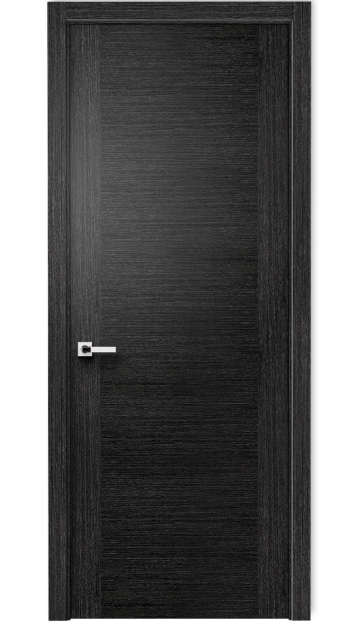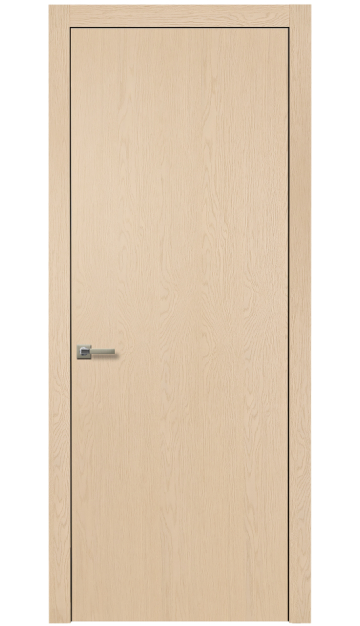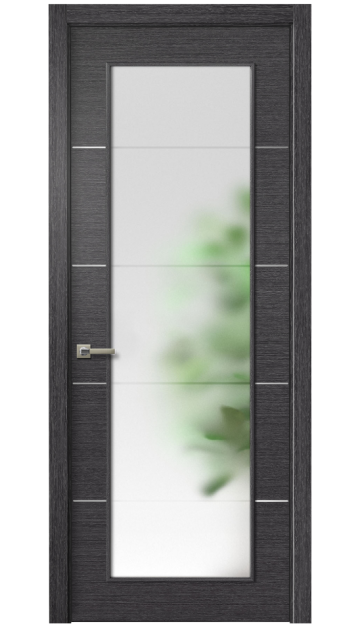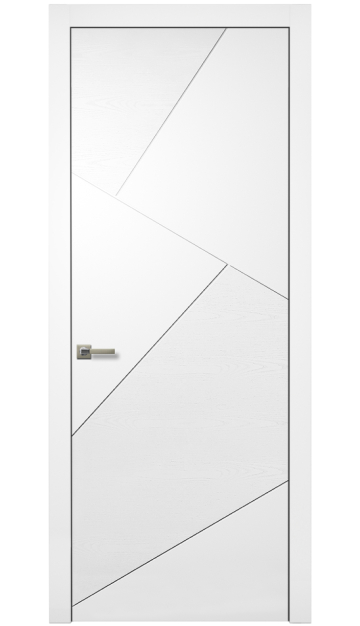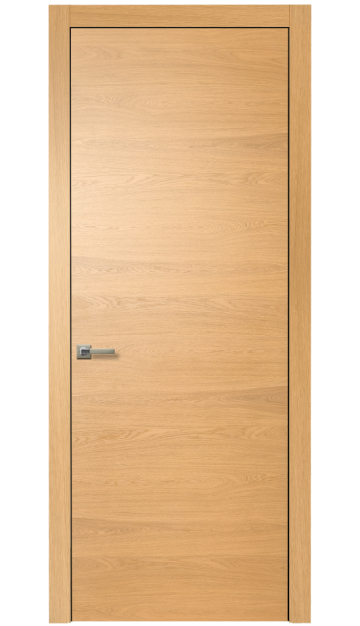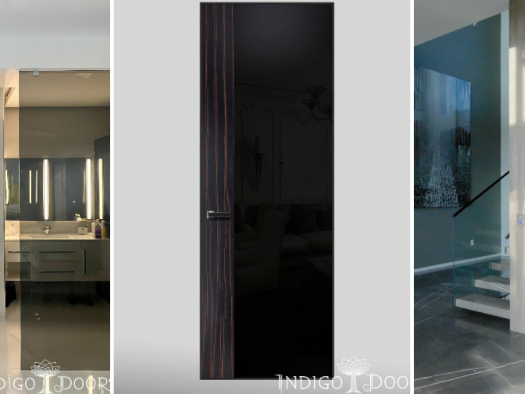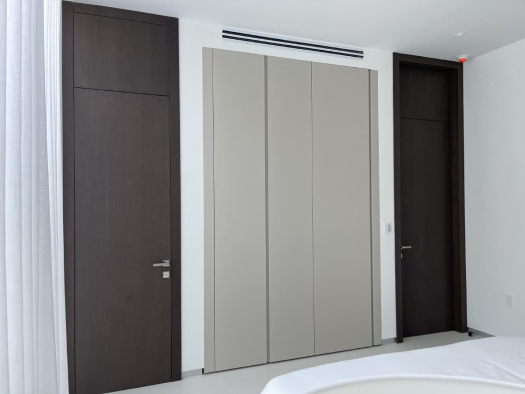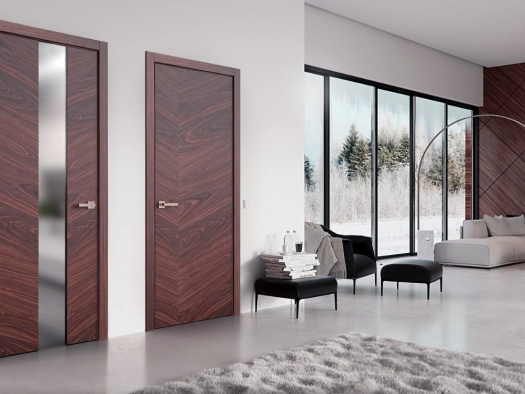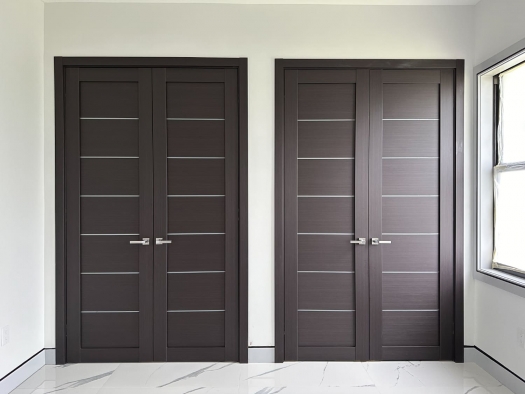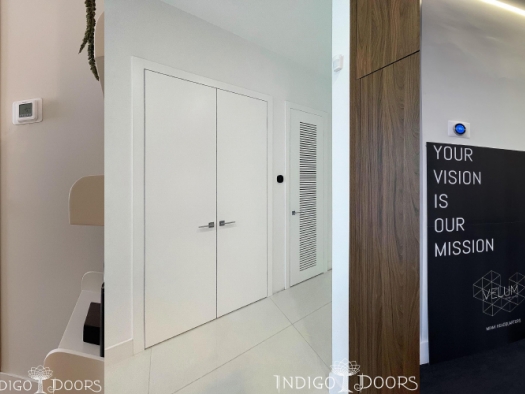- Why Your Interior Door Color Matters
- The Influence of Color in Interior Design
- Matching, Contrasting, or Complementing Your Surroundings
- Flooring and Door Color Harmony
- The Role of Lighting in Color Perception
- Selecting the Right Color for Each Room
- Popular Interior Door Colors in the USA
- How Finish Changes the Perception of Color
- Coordinating with Home Style and Hardware
- Avoiding Common Mistakes
- Why Choose Indigo Doors for Your Interior Doors
Why Your Interior Door Color Matters
When planning home décor, many homeowners focus on paint colors for walls, stylish furniture, or decorative accessories. Yet interior doors are equally important in shaping the atmosphere of your living space. The right color can make a room feel larger, cozier, more sophisticated, or more modern. On the other hand, the wrong color choice can disrupt the overall harmony of the design.
At Indigo Doors, we believe that an interior door is not just a functional element; it’s a design statement. With our Modern Interior Doors, Royal Collection, Frameless Doors (Invisible Doors), and Classic Collection, you can find the perfect shade and finish to match your home’s personality. Whether you want bright white, deep matte black, warm wood tones, or a custom-painted color, the selection process starts with understanding how door color interacts with the rest of your interior.
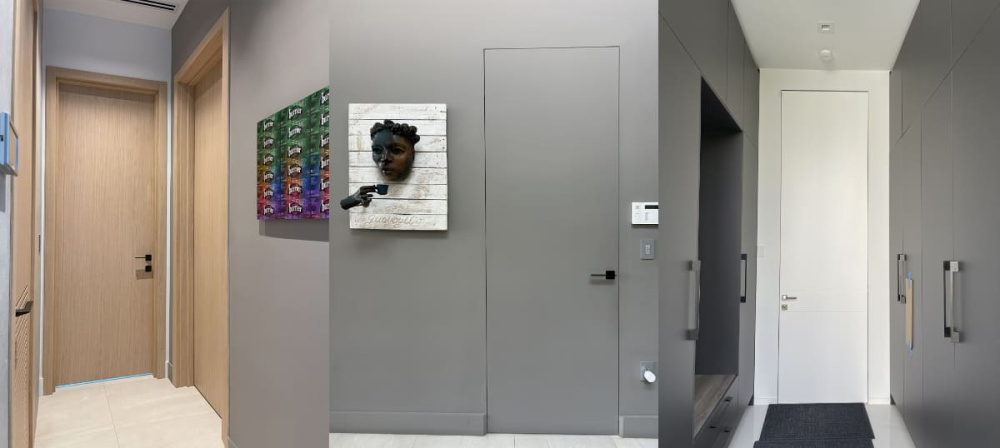
The Influence of Color in Interior Design
Color is a powerful tool in interior design. A white door can create a sense of cleanliness and openness, making even the smallest space feel more expansive. Black, on the other hand, is dramatic and sophisticated, perfect for adding a modern edge or a touch of luxury. Gray tones offer subtle elegance, bridging the gap between traditional and contemporary styles, while wood finishes introduce warmth and a natural, timeless appeal. For those who want a unique look, bold colors—such as navy blue, deep green, or rich burgundy—can become a central feature of the room.
Understanding these effects will help you decide whether your doors should blend seamlessly with the surroundings or stand out as a statement piece.
Matching, Contrasting, or Complementing Your Surroundings
When choosing a color for your interior doors, it’s essential to consider how they will relate to other elements in the room, particularly the walls, flooring, and trim. Some homeowners prefer matching their doors to the trim for a consistent and unified appearance. Others opt for contrast—imagine a crisp white wall paired with a deep black door—to make the entrance stand out as a bold architectural detail. There’s also a middle ground: choosing complementary tones from the same color family to create a balanced yet visually interesting look.
For example, a frameless door painted the same shade as the wall can “disappear” into the background, creating a sleek minimalist effect. Alternatively, a Royal Collection door in rich walnut can stand as a focal point in a modern living room with neutral walls.
Flooring and Door Color Harmony
The relationship between your flooring and door color can dramatically impact the overall feel of a space. Matching your doors to dark hardwood floors creates a sense of flow and elegance, but it can also make the space feel smaller if there isn’t enough natural light. In such cases, a lighter door color can lift and brighten the room.
For homes with light or neutral flooring, you have more flexibility—both matching and contrasting can work beautifully. A light oak floor with a medium-gray door can provide just the right amount of depth without overpowering the décor. If your flooring is patterned or has a strong wood grain, it’s often best to choose a more subtle door color to avoid visual competition between the two.
The Role of Lighting in Color Perception
Lighting is one of the most overlooked factors when selecting a door color. Natural light tends to bring out the warmth in lighter tones, while artificial lighting—especially LED or fluorescent—can make colors appear cooler or more muted. Before committing to a shade, view a sample in the actual room where the door will be installed, checking how it looks at different times of day.
Smaller rooms with limited light often benefit from lighter door colors, which reflect light and create a more spacious feel. Larger, open areas, however, can accommodate darker shades without feeling closed in. Hallways, which frequently lack natural light, can appear brighter and more inviting with a door color in a soft white or pale gray.
Selecting the Right Color for Each Room
Different rooms serve different purposes, and the color of your interior doors can help reinforce the intended mood. In the living room, neutral or warm tones work best because they pair well with a wide variety of furniture styles and color schemes. Bedrooms often call for calming shades like pastel gray, beige, or soft blue to encourage relaxation. Home offices benefit from sophisticated, darker colors that promote focus, such as charcoal or espresso. For children’s rooms, playful pastels or bright, cheerful colors can make the space feel energetic and fun.
Popular Interior Door Colors in the USA
Across the United States, certain interior door colors have become clear favorites among homeowners, especially in style-conscious cities like Miami, Orlando, Tampa, and Jacksonville. These colors not only reflect national design trends but also adapt beautifully to different interior styles and climates.
Here are some of the most popular choices and why they stand out:
- Matte black interior doors – Perfect for modern and industrial-style homes, matte black adds a bold, sophisticated touch and works especially well as a contrast against light-colored walls.
- Soft gray and greige (gray + beige) – These versatile shades blend effortlessly with almost any décor, offering a neutral yet stylish backdrop that’s ideal for both contemporary and classic interiors.
- Warm walnut and natural oak finishes – Timeless wood tones that bring warmth, texture, and a sense of craftsmanship to any space, making them a favorite for traditional and transitional designs.
- White doors with frosted glass inserts – Fresh, airy, and perfect for coastal or modern homes, these doors allow natural light to flow between rooms while maintaining privacy.
This mix of bold, neutral, natural, and light-enhancing options ensures that every homeowner can find a door color that complements their interior vision and lifestyle.
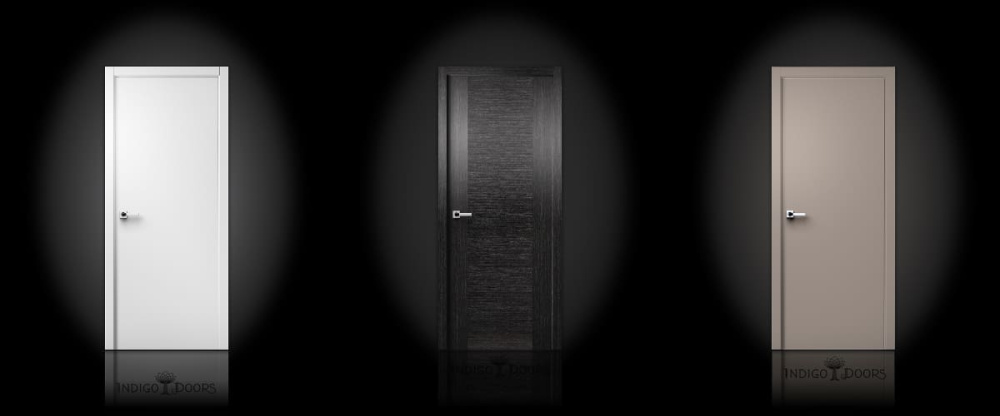
How Finish Changes the Perception of Color
Even if you’ve decided on the perfect color, the finish you choose can change its appearance and impact. A matte finish offers a subtle, modern aesthetic and hides fingerprints well, making it ideal for high-traffic areas. A semi-gloss finish is more reflective and easy to clean, which works well in kitchens or bathrooms. Doors with a visible wood grain provide additional texture, adding character and depth to the space.
Coordinating with Home Style and Hardware
Your home’s architectural style should also guide your color choice. Minimalist and contemporary homes often look best with frameless doors in monochrome shades, while classic interiors benefit from paneled white or richly stained wooden doors. Luxury spaces are enhanced by deep matte colors or high-quality wood finishes from the Royal Collection.
Hardware should never be an afterthought. The color and material of handles, hinges, and locks can either complement or clash with your chosen door color. For example, gold hardware pairs beautifully with dark navy or black doors, while chrome works well with light neutrals.
Avoiding Common Mistakes
When choosing the color for interior doors, there are a few common pitfalls that can undermine even the most well-planned design. Many homeowners select a shade based solely on how it appears in a store display, forgetting that lighting conditions at home can significantly alter its look. Others overlook the fact that a door is visible from both sides, meaning the chosen color must work for two different rooms. Additionally, coordinating the door color with hardware and trim is essential—otherwise, even the perfect shade can feel out of place.
Here are the most common mistakes and how to avoid them:
- Choosing without checking the color in different lighting – Always test the color sample in the actual room at various times of the day. Natural and artificial light can drastically change the shade’s appearance.
- Ignoring how the door looks from both sides – Since interior doors connect two spaces, ensure the chosen color complements the décor on both sides.
- Forgetting to coordinate hardware color – Handles, hinges, and locks should harmonize with the door’s finish. A mismatch can make the overall design feel inconsistent.
By keeping these points in mind, you can avoid design regrets and ensure your interior doors enhance, rather than disrupt, the flow of your home.
Why Choose Indigo Doors for Your Interior Doors
At Indigo Doors, we pride ourselves on offering an extensive selection of colors and finishes to suit any home style, from minimalist modern apartments to timeless classic interiors. Each of our collections—Modern, Royal, Frameless, and Classic—is crafted from high-quality materials with meticulous attention to detail. We also provide custom color options, so your doors can perfectly match your unique vision. With our headquarters in Florida and nationwide shipping, we make it simple for homeowners across the USA to find their ideal interior doors.
Here’s why customers choose Indigo Doors:
- Wide color range – from white to deep matte black – giving you the flexibility to match or contrast your door with any interior style.
- Custom finishes – tailored to your home’s style – allowing for personalized solutions that reflect your taste and personality.
- Premium collections – Modern, Royal, Frameless, Classic – offering a variety of designs to fit both contemporary and traditional spaces.
- Nationwide shipping – serving customers across the USA – ensuring you can enjoy Indigo Doors quality no matter where you live.
By combining design flexibility, premium craftsmanship, and convenient delivery, Indigo Doors makes choosing the perfect interior doors an effortless and satisfying experience.
Conclusion
The right interior door color can enhance your home’s beauty, improve visual harmony, and reflect your personal style. Whether you’re aiming for understated elegance or bold contrast, taking the time to consider lighting, flooring, and overall design will ensure your choice is both beautiful and practical. Indigo Doors is here to help you every step of the way, offering expert advice and a wide range of color options to bring your vision to life.

